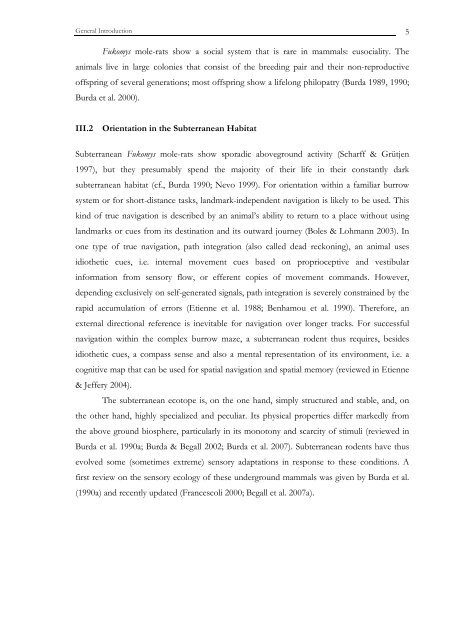Antigen Biotinylated Anti-Rabbit lgs Rabbit Primary Antiserum AB ...
Antigen Biotinylated Anti-Rabbit lgs Rabbit Primary Antiserum AB ...
Antigen Biotinylated Anti-Rabbit lgs Rabbit Primary Antiserum AB ...
You also want an ePaper? Increase the reach of your titles
YUMPU automatically turns print PDFs into web optimized ePapers that Google loves.
General Introduction<br />
Fukomys mole-rats show a social system that is rare in mammals: eusociality. The<br />
animals live in large colonies that consist of the breeding pair and their non-reproductive<br />
offspring of several generations; most offspring show a lifelong philopatry (Burda 1989, 1990;<br />
Burda et al. 2000).<br />
III.2 Orientation in the Subterranean Habitat<br />
Subterranean Fukomys mole-rats show sporadic aboveground activity (Scharff & Grütjen<br />
1997), but they presumably spend the majority of their life in their constantly dark<br />
subterranean habitat (cf., Burda 1990; Nevo 1999). For orientation within a familiar burrow<br />
system or for short-distance tasks, landmark-independent navigation is likely to be used. This<br />
kind of true navigation is described by an animal’s ability to return to a place without using<br />
landmarks or cues from its destination and its outward journey (Boles & Lohmann 2003). In<br />
one type of true navigation, path integration (also called dead reckoning), an animal uses<br />
idiothetic cues, i.e. internal movement cues based on proprioceptive and vestibular<br />
information from sensory flow, or efferent copies of movement commands. However,<br />
depending exclusively on self-generated signals, path integration is severely constrained by the<br />
rapid accumulation of errors (Etienne et al. 1988; Benhamou et al. 1990). Therefore, an<br />
external directional reference is inevitable for navigation over longer tracks. For successful<br />
navigation within the complex burrow maze, a subterranean rodent thus requires, besides<br />
idiothetic cues, a compass sense and also a mental representation of its environment, i.e. a<br />
cognitive map that can be used for spatial navigation and spatial memory (reviewed in Etienne<br />
& Jeffery 2004).<br />
The subterranean ecotope is, on the one hand, simply structured and stable, and, on<br />
the other hand, highly specialized and peculiar. Its physical properties differ markedly from<br />
the above ground biosphere, particularly in its monotony and scarcity of stimuli (reviewed in<br />
Burda et al. 1990a; Burda & Begall 2002; Burda et al. 2007). Subterranean rodents have thus<br />
evolved some (sometimes extreme) sensory adaptations in response to these conditions. A<br />
first review on the sensory ecology of these underground mammals was given by Burda et al.<br />
(1990a) and recently updated (Francescoli 2000; Begall et al. 2007a).<br />
5

















